You can stop watering new grass seed daily once it has germinated and the grass blades measure to about 1 inch. This should take between 3-4 weeks from planting. Once you’ve reached this stage, you can water your new grass seed with approximately 1 inch of water 1-2 times a week.
Planted some new grass seed and confused about just how much water is enough for it to flourish?
If you feed your new grass seed too much water, it’ll drown in excess moisture and you can say goodbye to that perfect and healthy lawn. Similarly, if you don’t water it enough, the seedlings are going to dry out.
Hitting that *sweet* spot can be quite tricky, but fear not, I’ve got all the tips and tricks to help you out! Keep reading to find out everything you need to know about when to stop watering new grass seed!
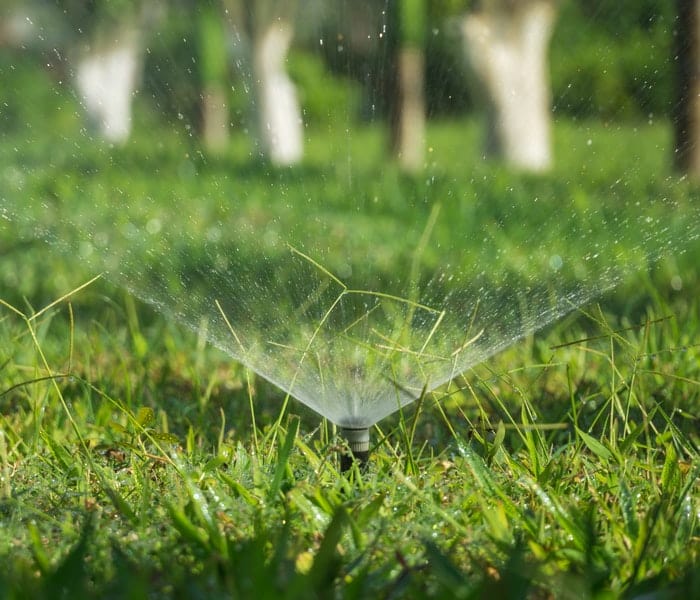
Let’s Start At The Beginning – Lawn Planting 101
Determining when to stop watering your new grass seeds is dependent on how well you’ve prepared the soil before planting your new seed.
Basically, if you haven’t prepared the soil well, the stage at which you can stop watering the seeds daily will differ compared to if you actually prepared the soil well.
Your soil won’t even be able to sustain new growth if it hasn’t been prepared well, so before we even get to thinking about when we can stop watering the seeds, let’s make sure we’ve got the bases covered.
P.S. Not sure which grass type you should opt for? Check out this article for reviews of 5 types of grass, especially if you live in Florida!
Preparing The Soil
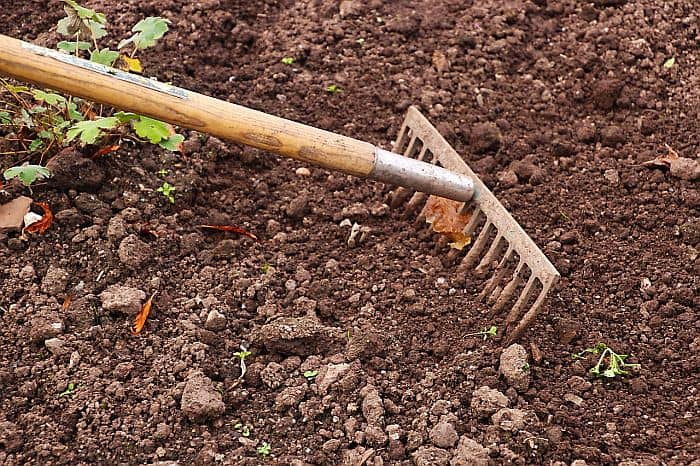
Preparing the soil involves loosening it so that the seeds have enough room to make contact with the soil around it. This step is pretty easy and you just need a simple rake to get your soil loose and remove any stones that may be lodged in there.
If you’re concerned about the health of your soil and would like to give it a nutrient boost, you can spread some fertilizer at this stage, once you’ve got loose soil.
The next step in the preparation stage is to water the soil. This should be done around 2-3 days before you plant the new seed. The soil needs to be watered thoroughly, to a depth of between 6-8 inches.
Pro tip: Remember to refrain from exerting any pressure onto the soil once you’ve watered it. If you walk on it, for example, that will defeat the purpose of loosening the soil because it will now be compact, leaving no room for the grass seedlings to settle in between the soil particles. This will also negatively impact soil moisture.
Planting The Seeds
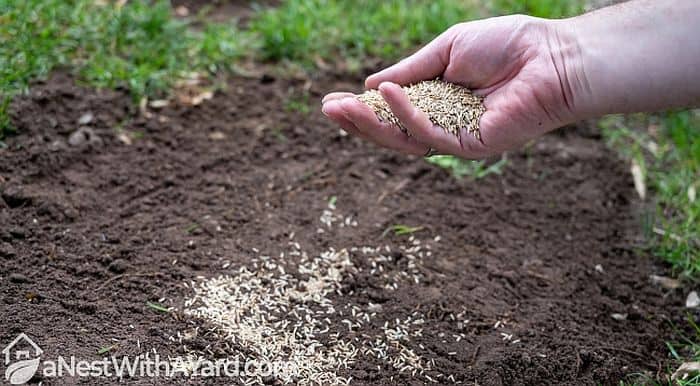
Now that your soil is well prepared, it’s time to grab those gardening gloves and plant those seeds. For the best results, you should pay attention to the season and whether conditions are favorable for planting new grass seed.
Remember that in order for new seeds to thrive, they need a good balance of sunlight, moisture and warmth. So, it’s definitely best to refrain from planting grass seeds in the dead of winter because their chances of flourishing are quite poor, as they will probably lack sunlight and warmth.
The type of grass you’re looking at planting is also a major consideration because they all adapt to certain weather conditions differently, which greatly influences their growth and long-term development.
A much-loved option is Bermuda grass because it’s a relatively low-maintenance type of grass among warm-season grasses. It also grows faster than any other grass of its type.
When you’re ready to plant your seeds, simply spread them over the soil and lightly rake over it. The purpose of raking over the soil is so that the seeds get covered with a thin layer of it.
Check out this detailed video on planting new grass seed by YouTube user OutdoorLife to give you a better idea of how to go about planting your seed:
Watering Newly Planted Grass Seeds
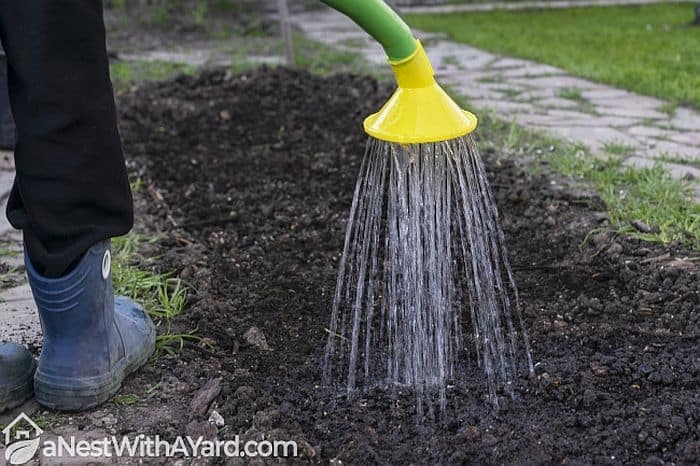
In the first month of planting, grass seeds are still quite delicate because they are just germinating and so they should be treated with care.
How long grass seeds take to grow varies depending on several factors, but once germination has taken place, in approximately a month, it gets slightly easier to maintain and requires less frequent watering.
Watering Grass Seeds In The First Month Of Planting
During this time, lawn seeds are still working on germinating and then sprouting, so the amount of water applied to the soil needs to be just right.
In this first month, you should aim to keep the soil moist but not drenched in water in an effort to encourage germination. The amount of water that they need during this time depends on several factors but the most important include:
- Local rainfall
- Average temperature
- Amount of shade and sunshine covering the soil
So, how much water do these new grass seedlings need and how often should you water them? You should definitely account for the above factors, but there is a general rule of thumb you could use to get adequate soil moisture.
Generally speaking, you should water the soil twice a day for about 10-15 minutes at a time, in the first month. The first ideal time for watering is early morning before the sun’s rays and heat have reached their peak because this ensures a lower chance of evaporation. The specific time for this is usually between 4:00 and 10:00.
The second ideal time is in the late afternoon. Evening watering is also preferred as an alternative. This will give the soil enough time to dry out before nightfall.
Obviously, if it’s been pouring buckets, temperatures have dropped drastically and the sun is nowhere to be seen, you will need to adapt this to suit your circumstances.
The process sounds like it can be quite taxing, but if you have a good hose pipe with a nozzle that’ll help you water the soil evenly, you shouldn’t have any problem at all. And even if you have a cheap lawn sprinkler system in place, you can simply set up timers and you’ll be good to go! One of the most recommended sprinklers is the MAXFLO Mini .
Keep in mind that the soil shouldn’t be soaked in water throughout the night because it will suffocate and increase the chance of disease.
Check out this YouTube video by Ryan Knorr Lawn Care for a great visual representation of how to water new grass seeds:
Watering New Grass Seed After Germination
You will know that all your grass seeds have germinated when you notice an even and consistent layer of green sprouts on the surface of your soil. The germination of each grass seed ranges from 3 weeks to a month, or sometimes longer.
Keep in mind that not all seeds will germinate at the same time, so you will need to continue watering them twice a day until they have all germinated.
Your watering routine should only change once the sprouts that grow into single blades eventually develop into a larger plant. There are several factors, such as your climate and grass seed type, the quality of seed brands used and soil type, which impact how long this will take.
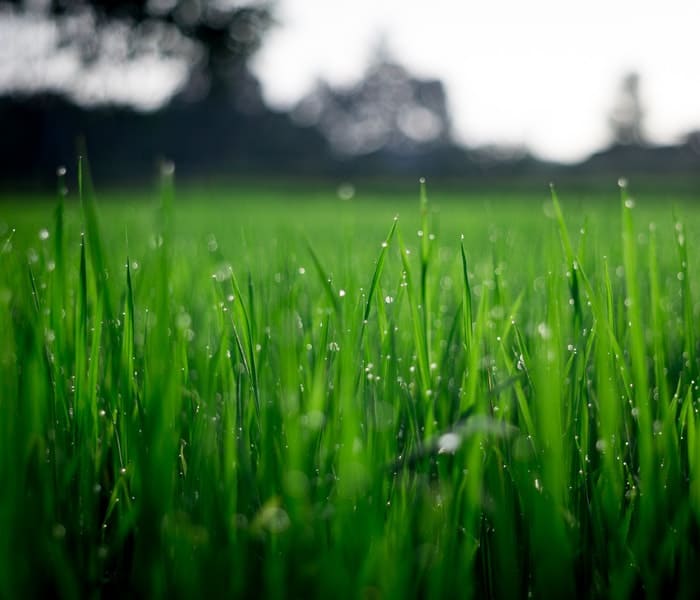
You can stop watering twice a day once you notice a consistent layer of single blades forming. Now, you can water grass seed every second or third day, depending on the weather conditions in your area.
Make sure you maintain light watering because you don’t want to drench and suffocate the blades of new grass. You can change to deep watering only when the plant has established deep roots.
The reason behind this change is that your new grass is transforming from fragile sprouts into new grass plants with root growth. If you allow the soil moisture to dry up in between watering sessions, this will promote deeper root growth as they search for nutrients and moisture.
The process generally takes longer when you’re starting from scratch, but if you have an existing lawn, your seeds shouldn’t take too long to start developing.
This awesome YouTube video by Garden Lawncare Guy shows a 4-week time-lapse of newly planted seeds:
FAQs
How Often Do You Water New Grass Seed?
You should water new grass seed every day early in the morning and in the late afternoon. When watering, make sure that you do it consistently and that the water is applied evenly.
Should You Keep New Grass Seed Wet?
You should keep new grass seed wet. This is because seeds require moisture to help them reach the germination stage.
Is It OK To Water Grass Everyday?
It is not OK to water grass everyday. The exception to this rule is if you’ve just planted new grass seed because it requires moisture to germinate. Fully grown grass should not be watered every day because too much moisture will result in shallow roots.
Ready To Get Watering?
As you can see, watering new grass seed after planting depends on several factors, so there really isn’t a one-size-fits-all type of answer involved here. The best way to figure it out is to monitor your environment and how well the grass type you’ve chosen appears to be adapting.
I hope I was able to give you some insight into how to determine how much water your grass seeds need from the time it’s planted until they’re ready for their first mow. Please leave a comment below if you enjoyed the article. I’d love to hear from you!
Last update on 2022-03-17 at 16:29 / Affiliate links / Images from Amazon Product Advertising API






More Stories
Halogen Vs LED Under Cabinet Lighting
5 Practical And Aesthetically Pleasing Home Renovations And Add-Ons
A Mark of Distinction: Custom Closets and Cabinets